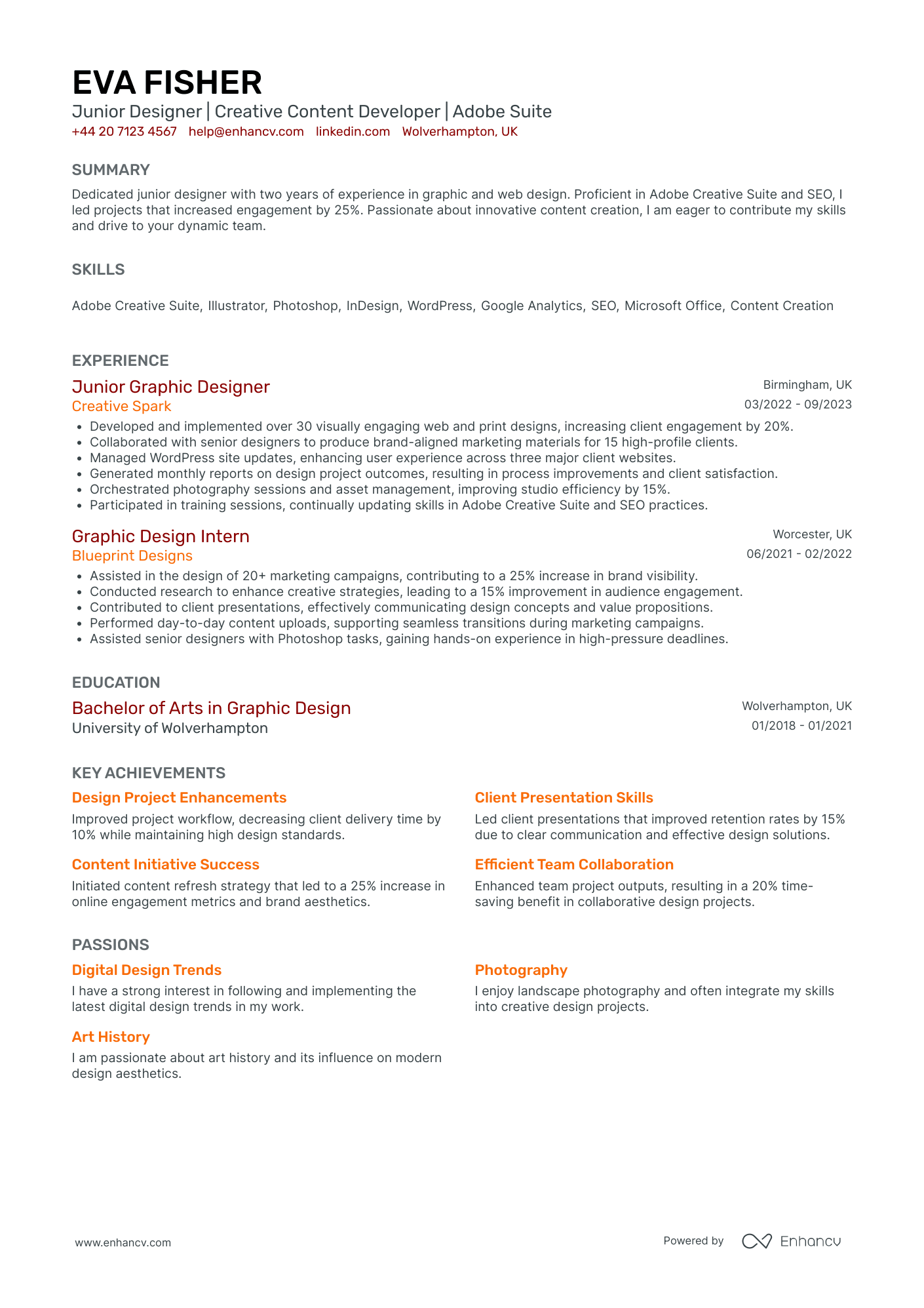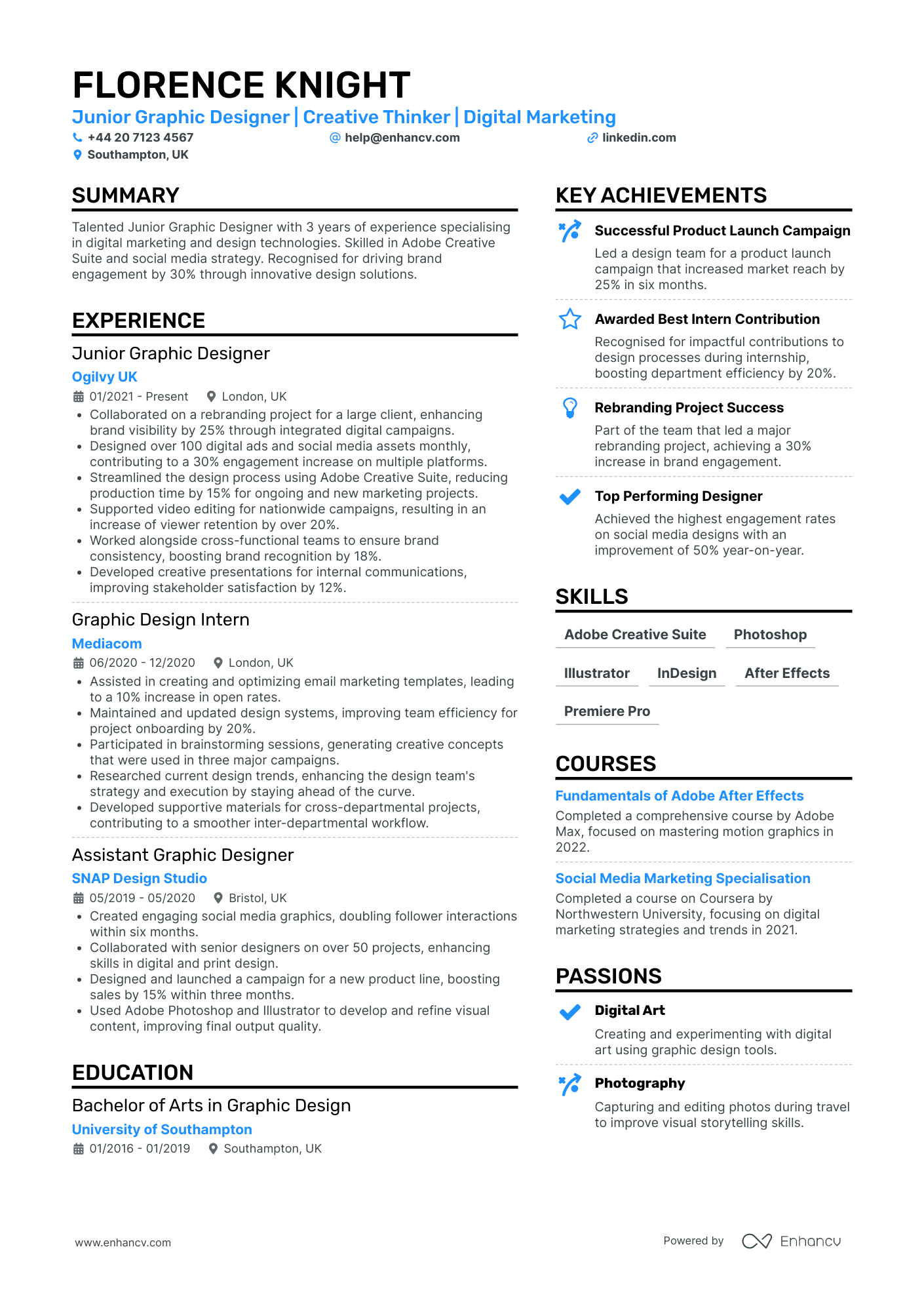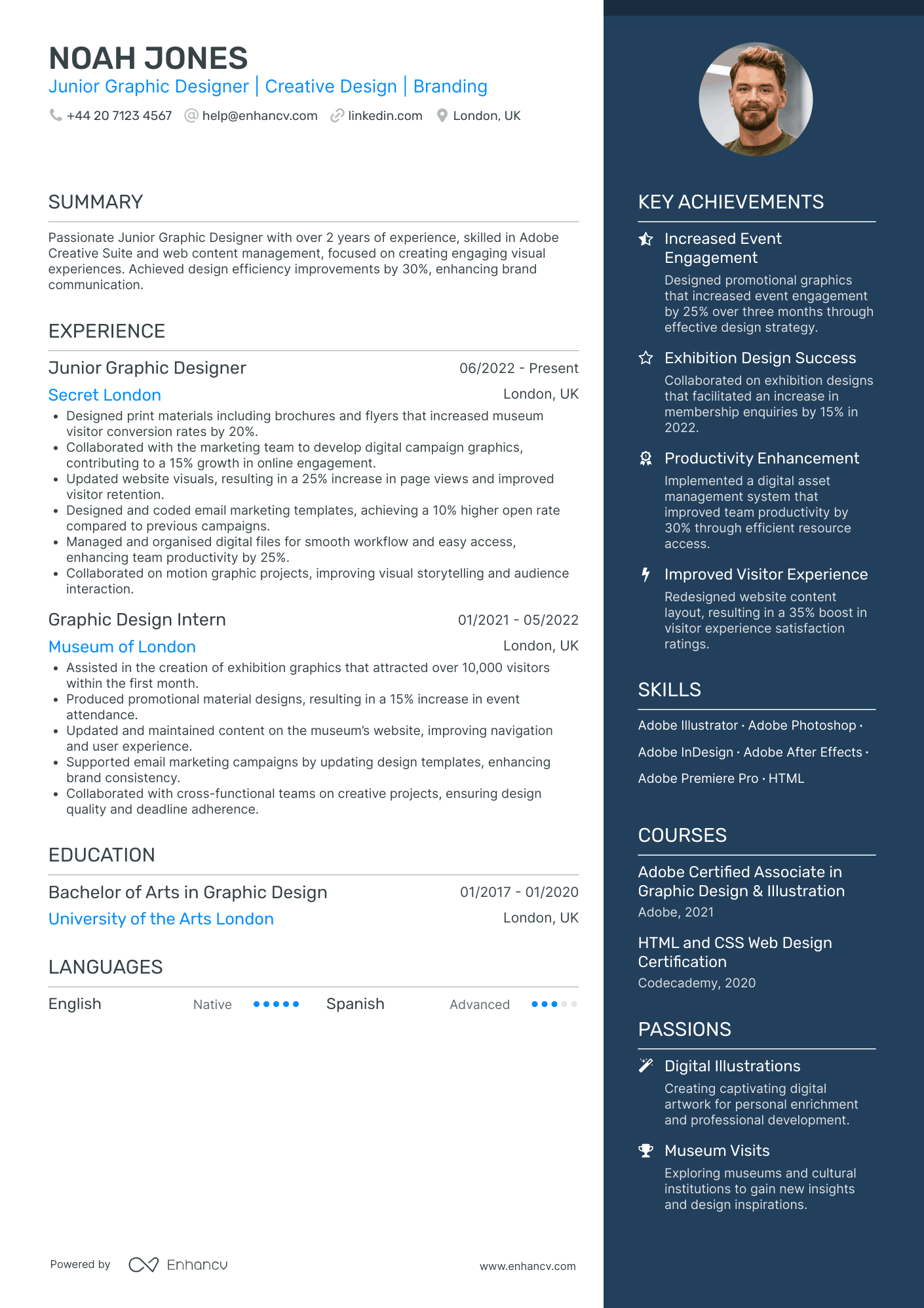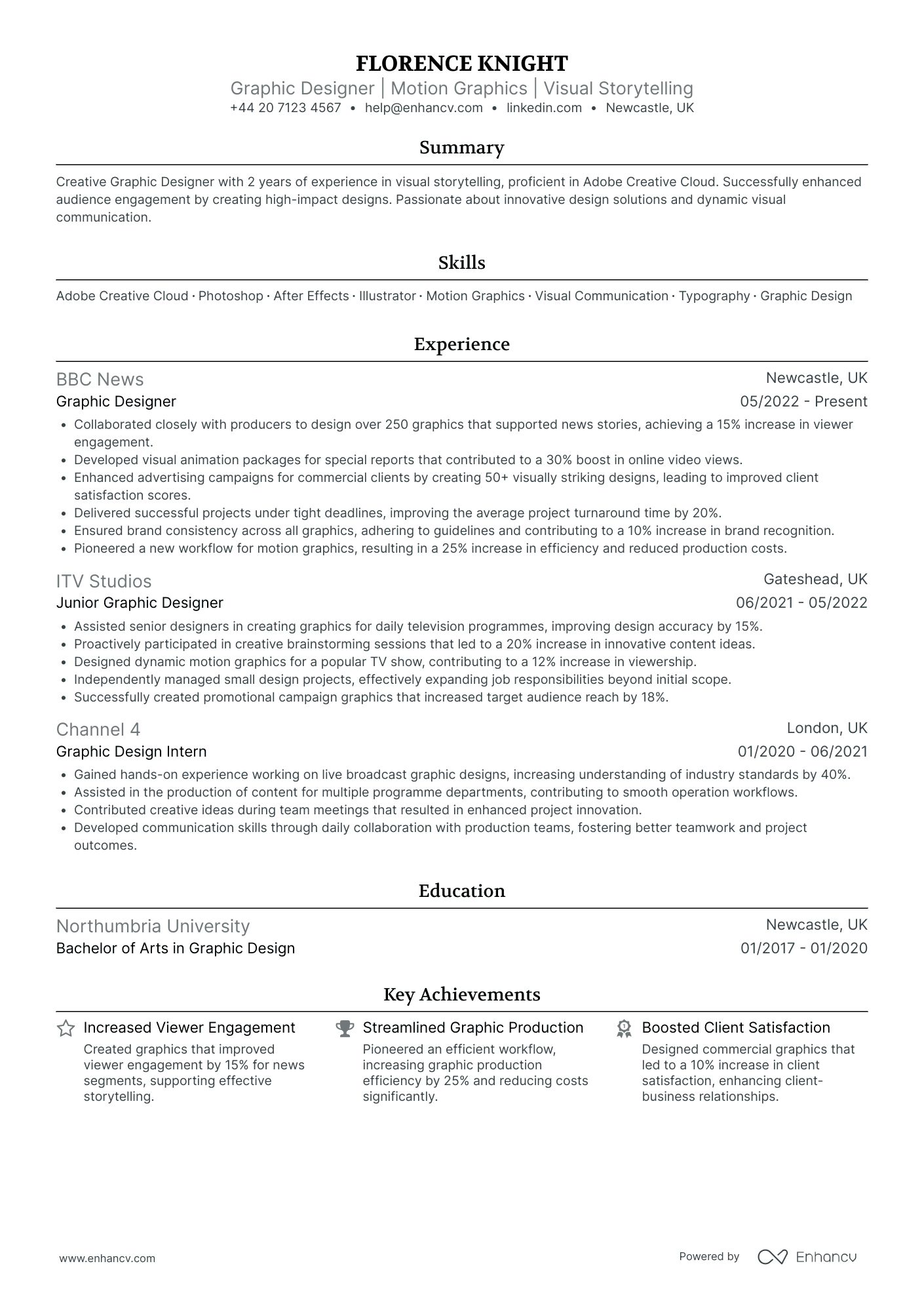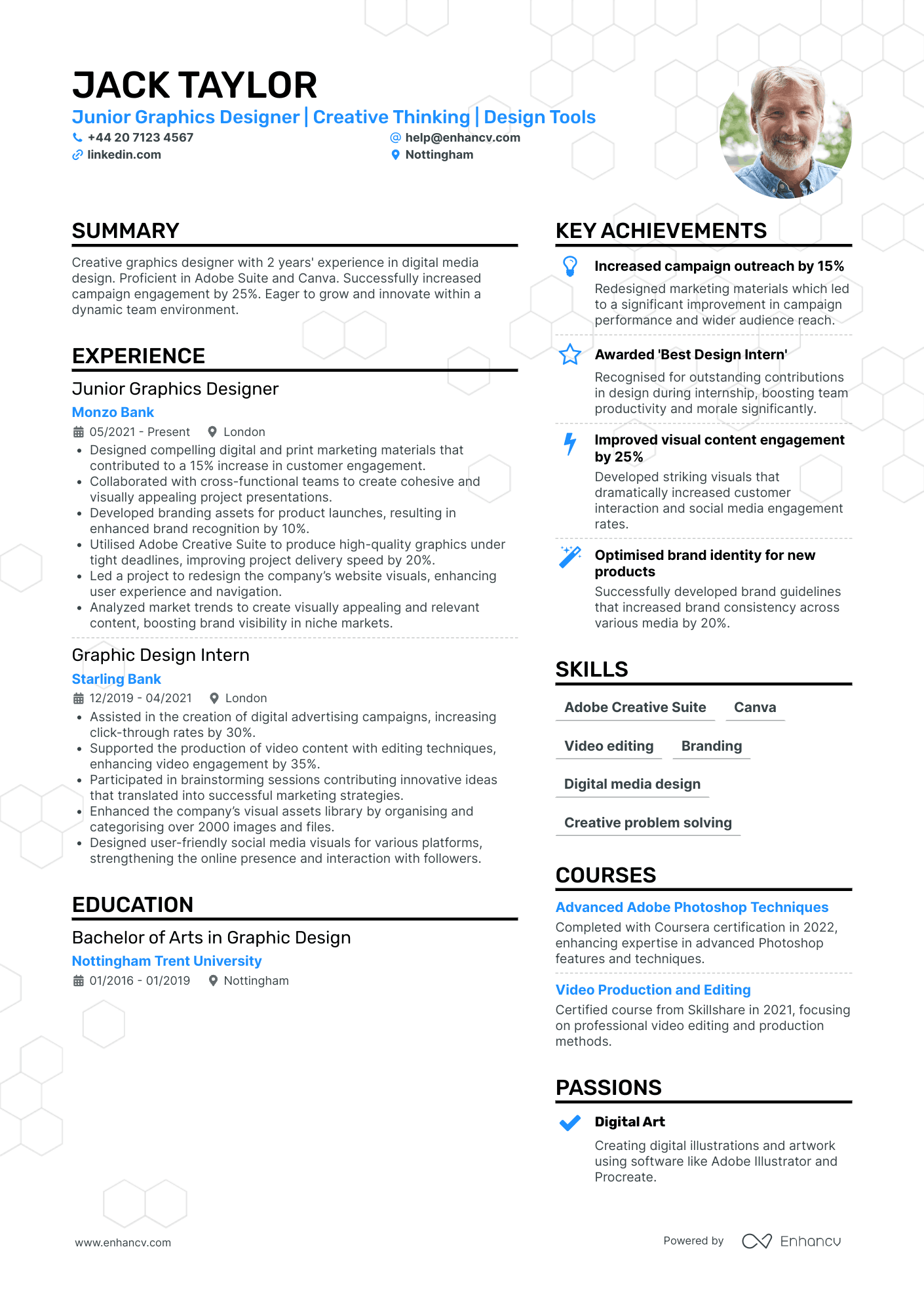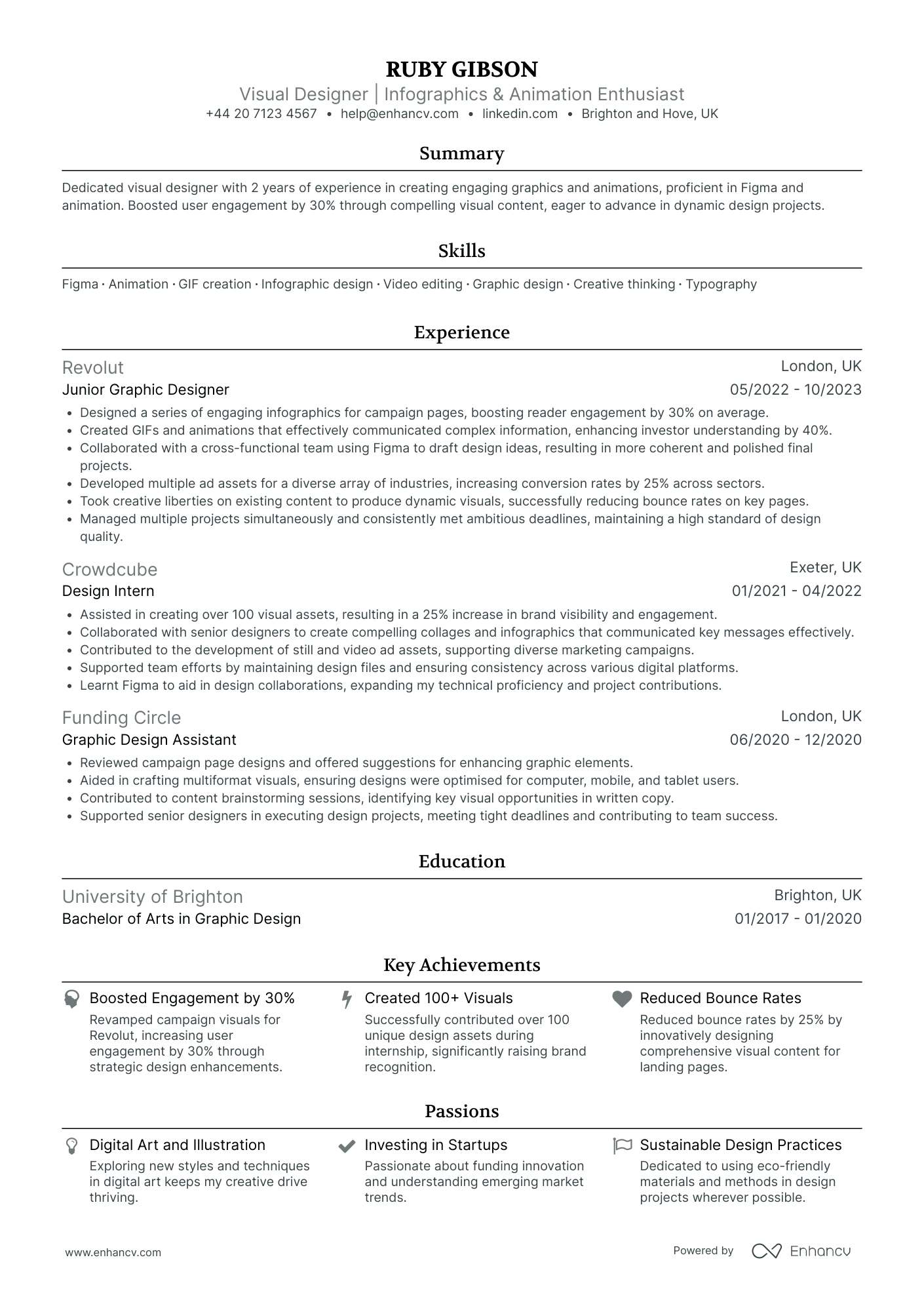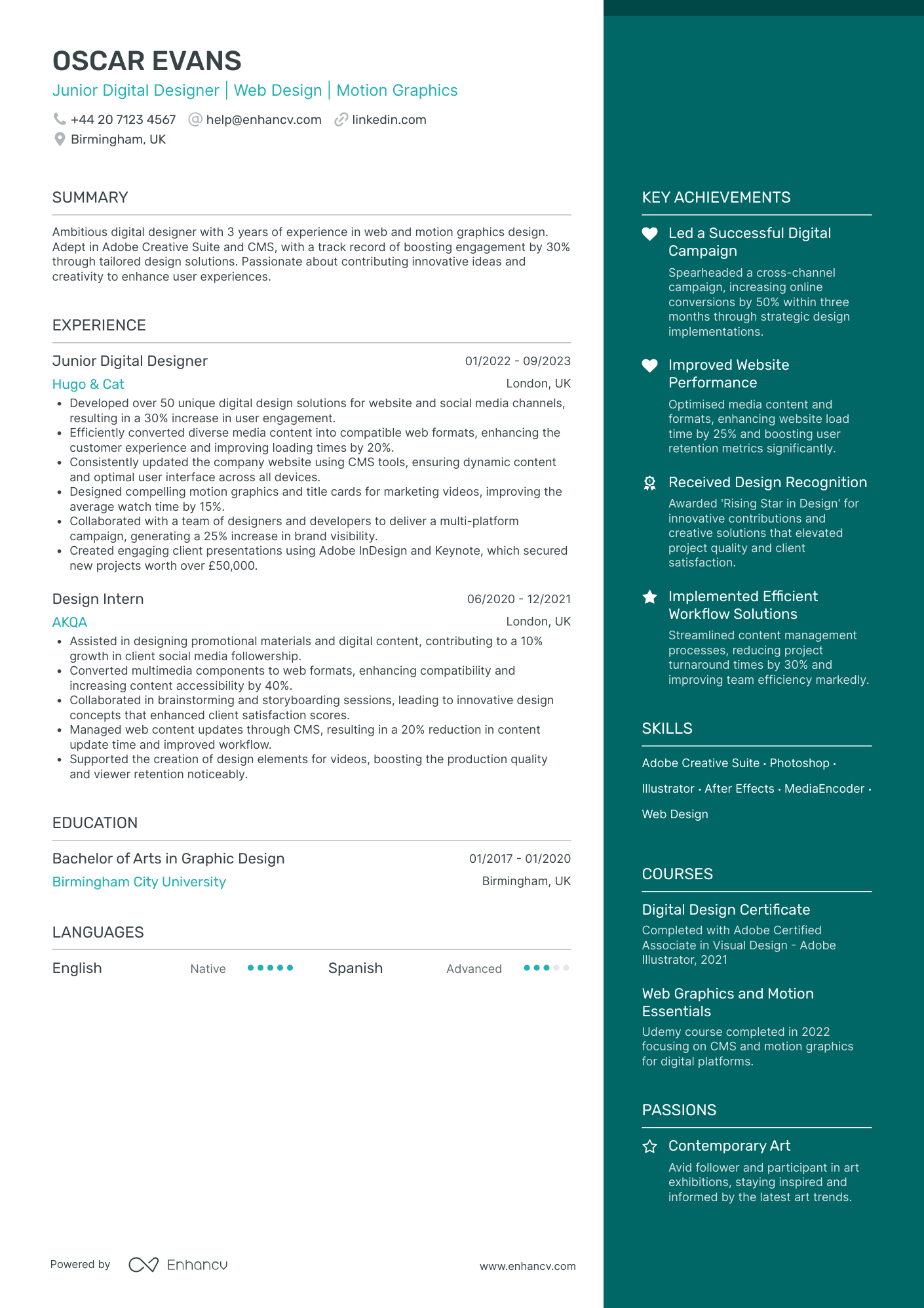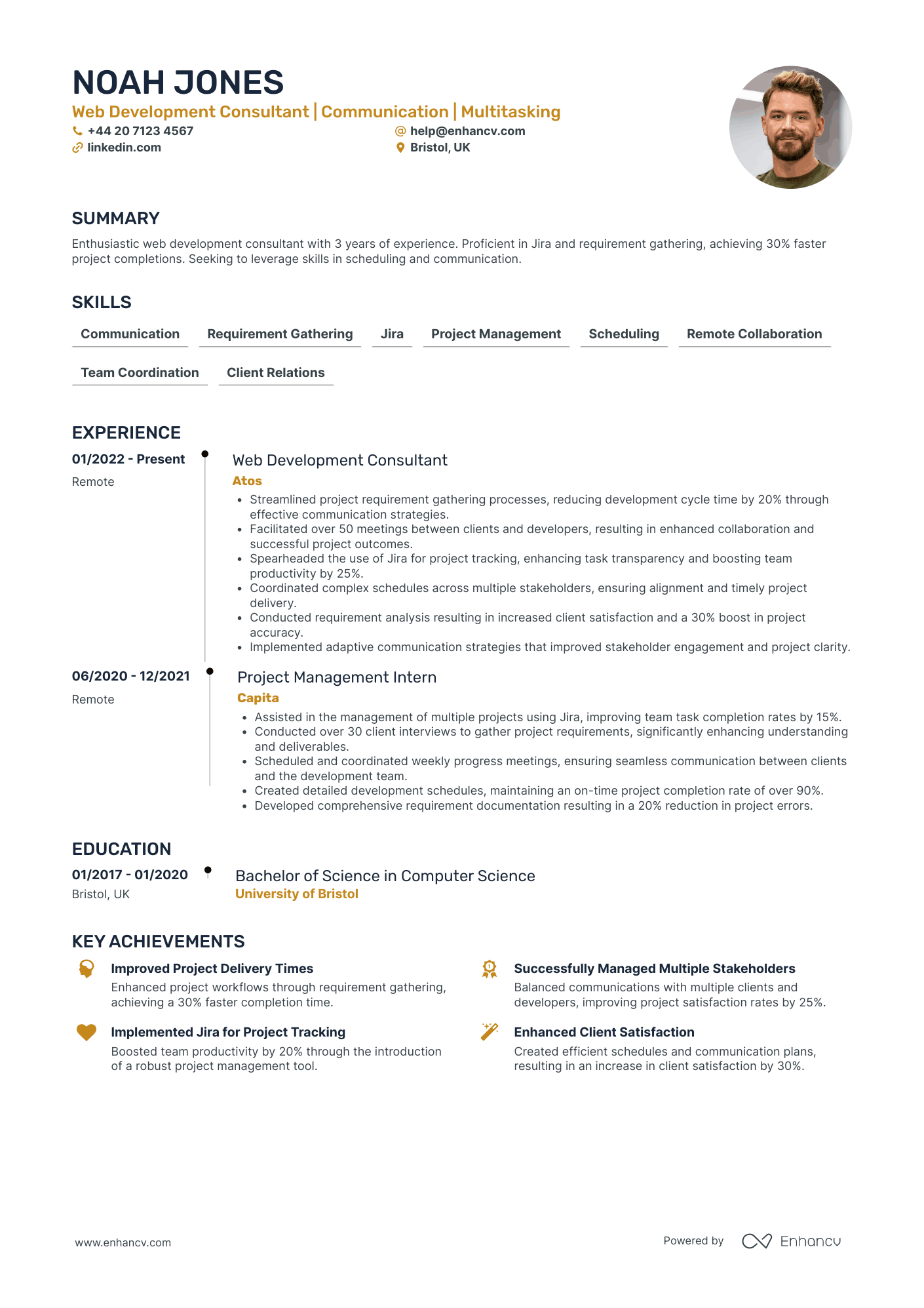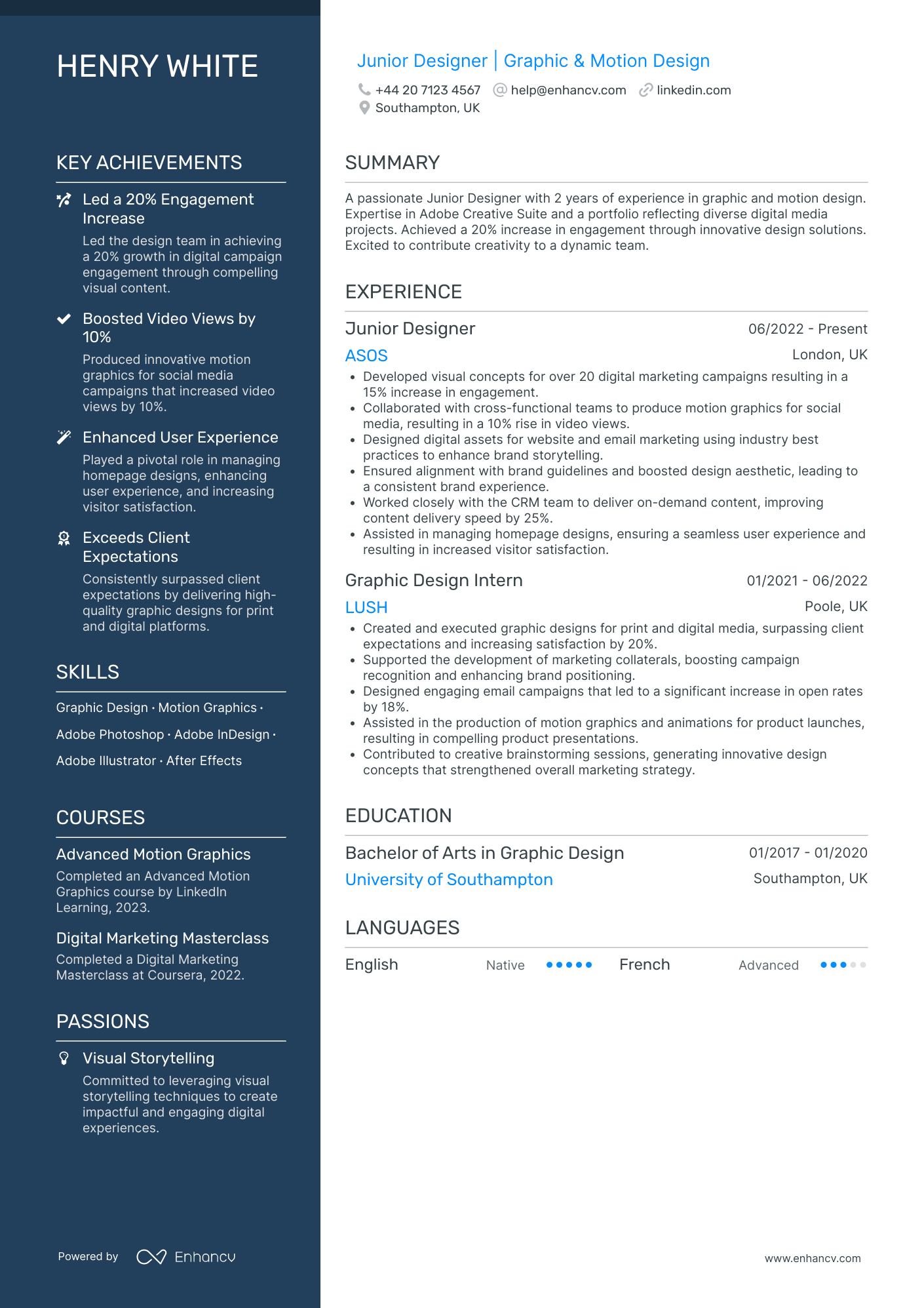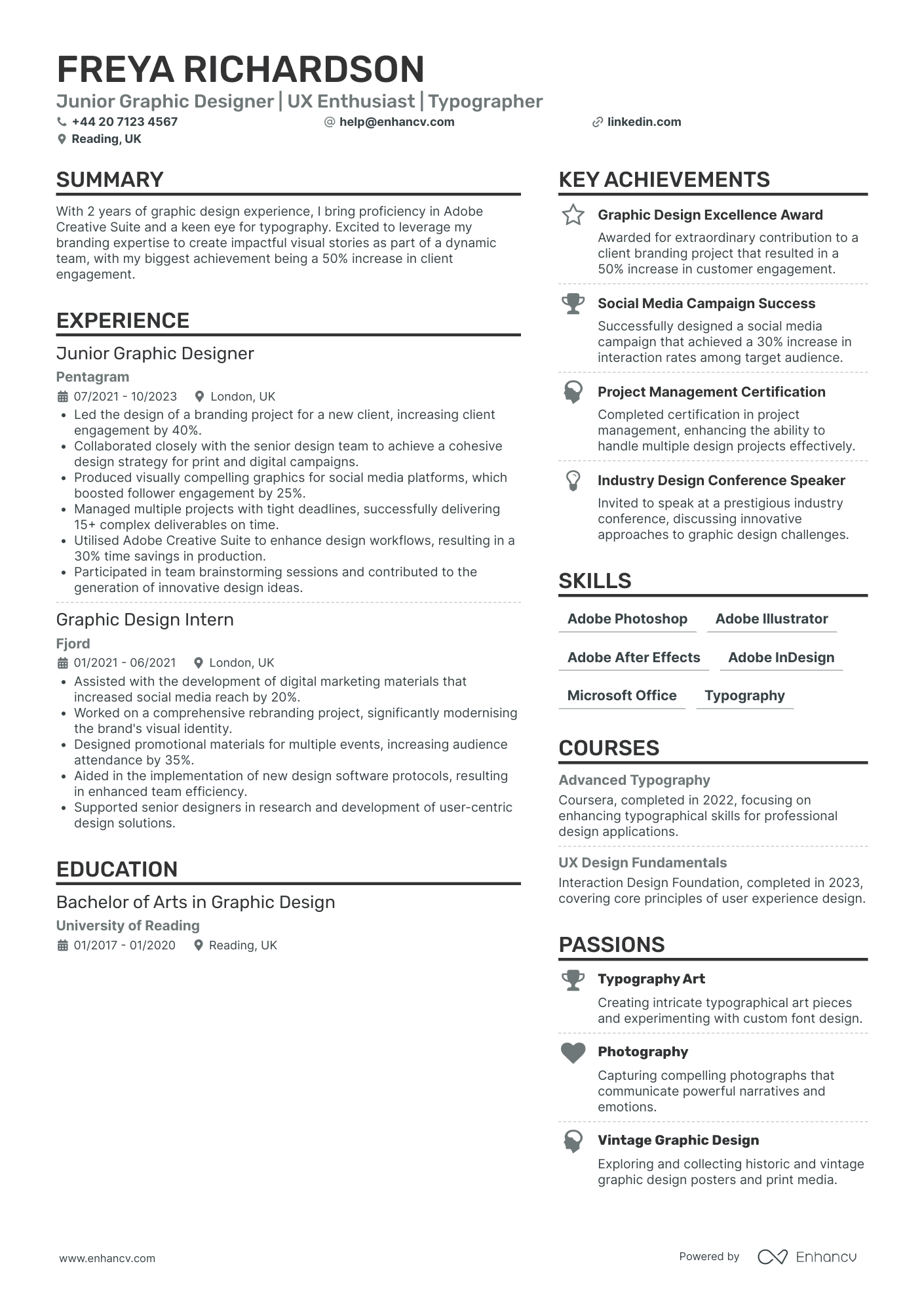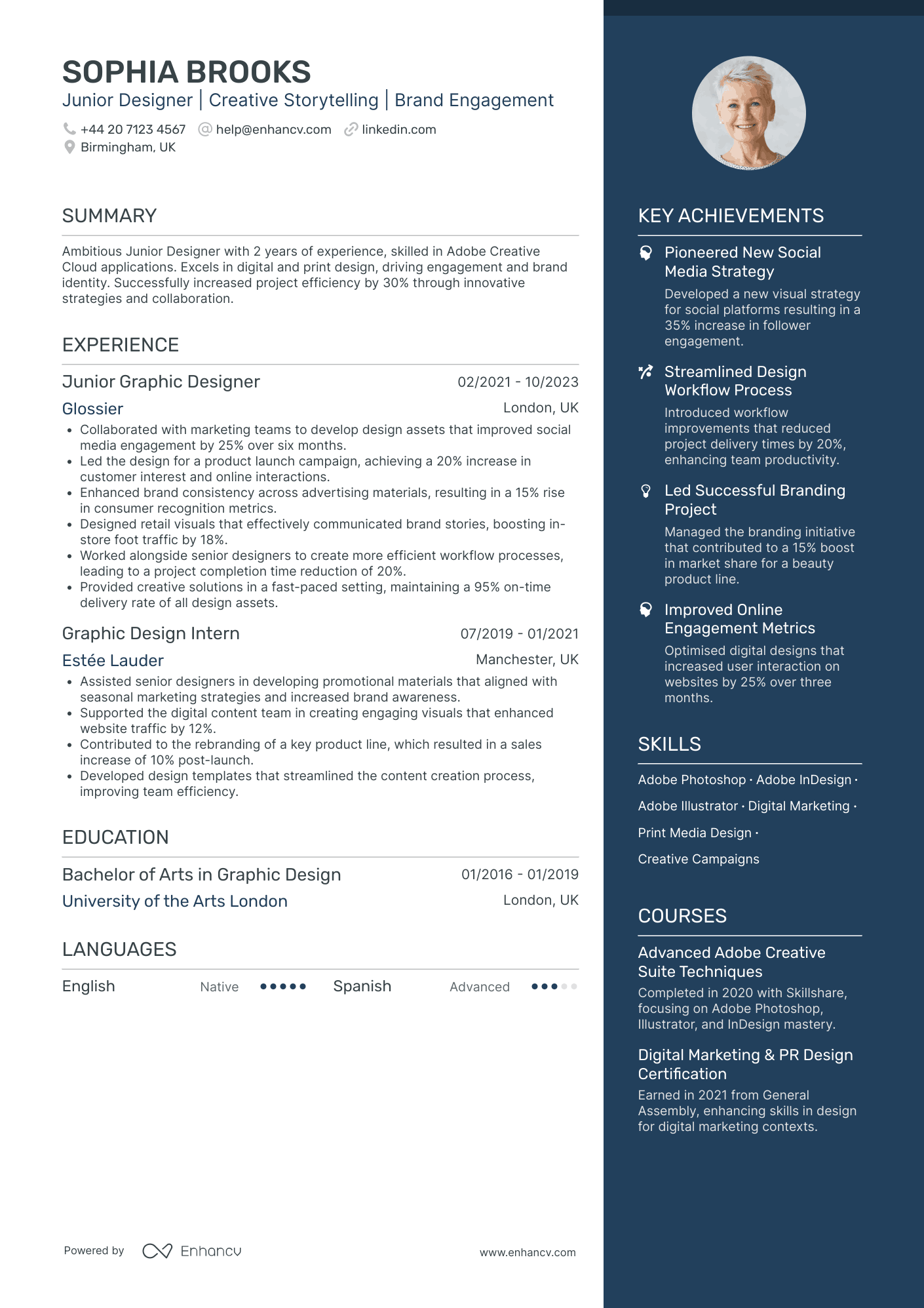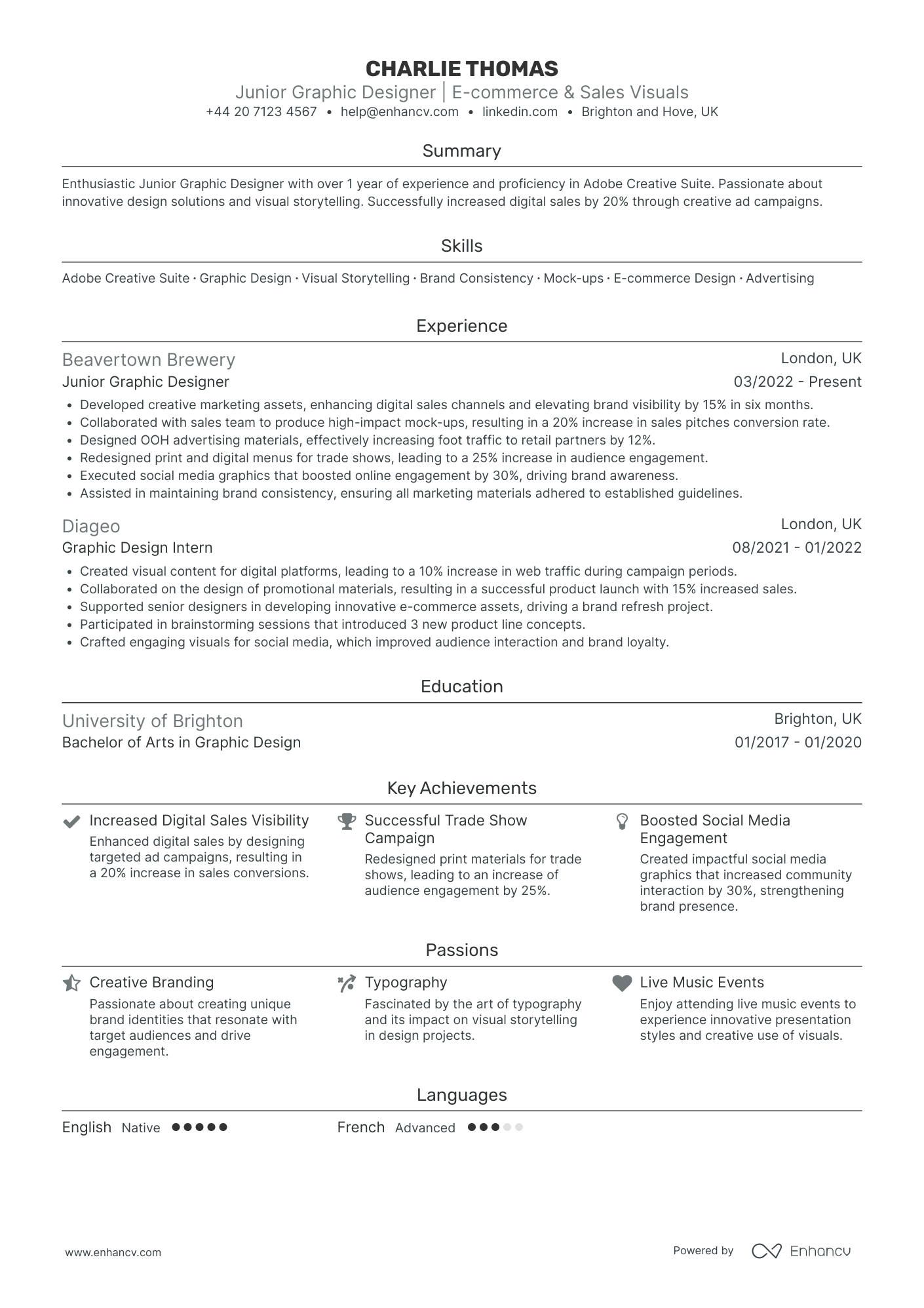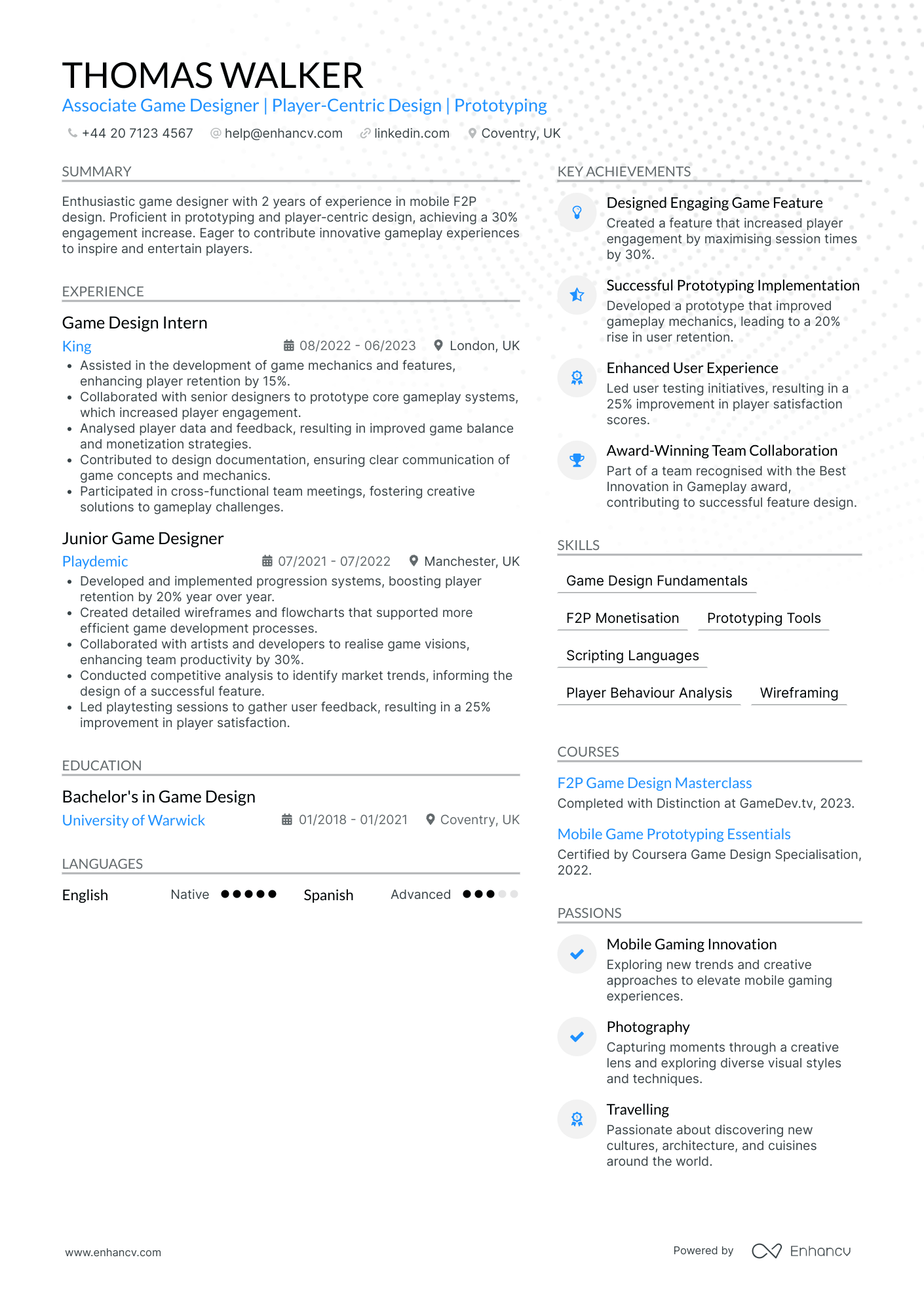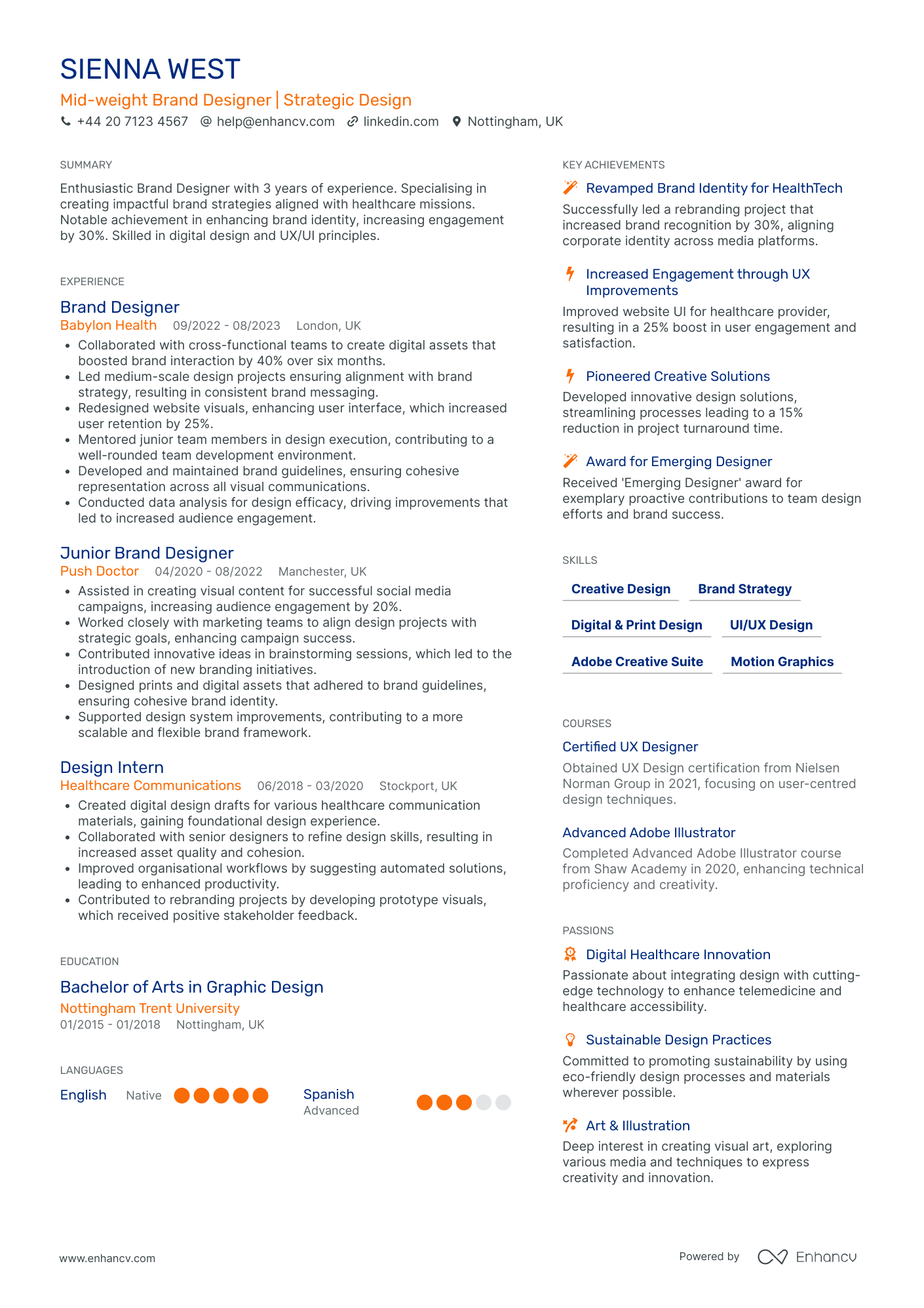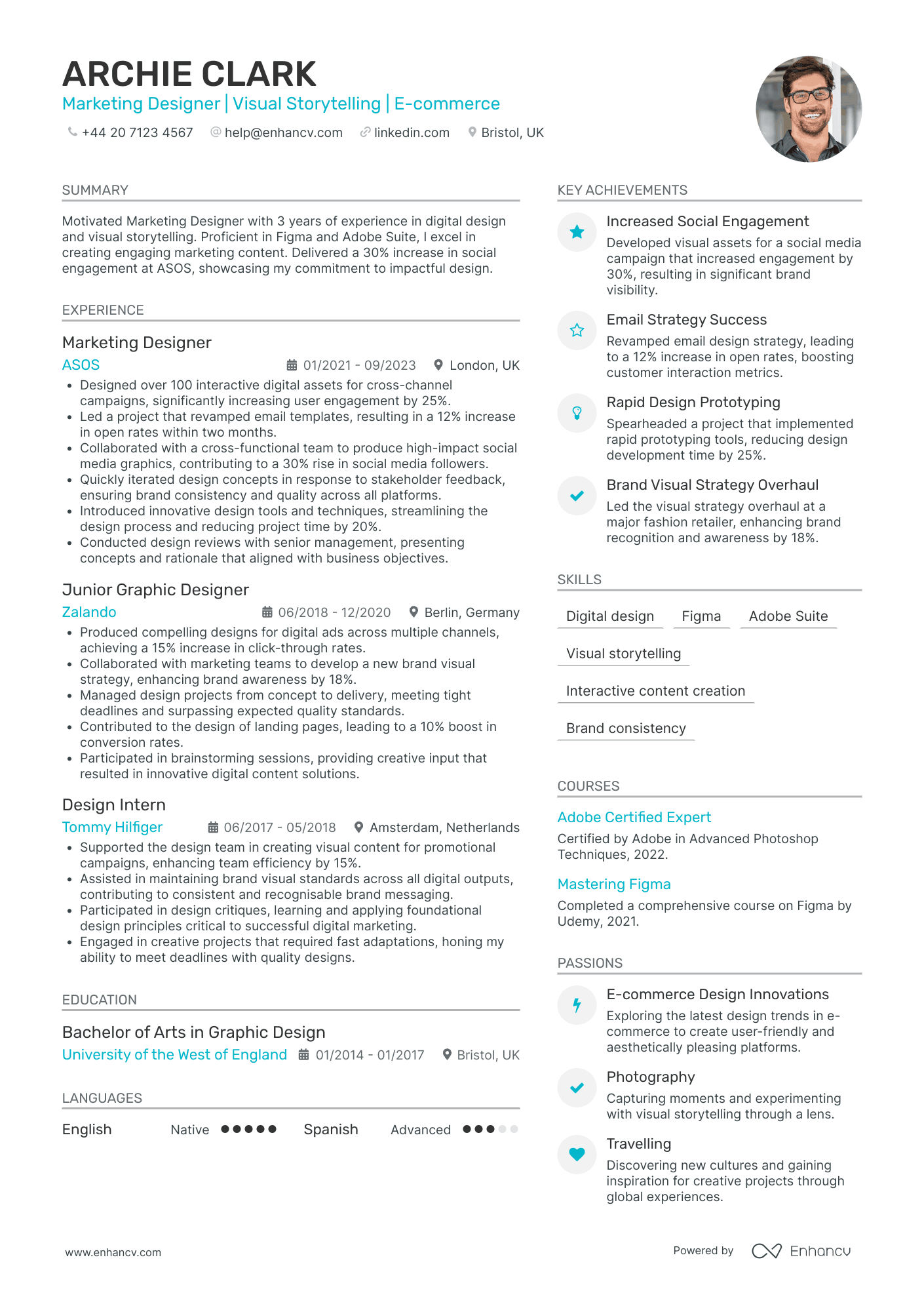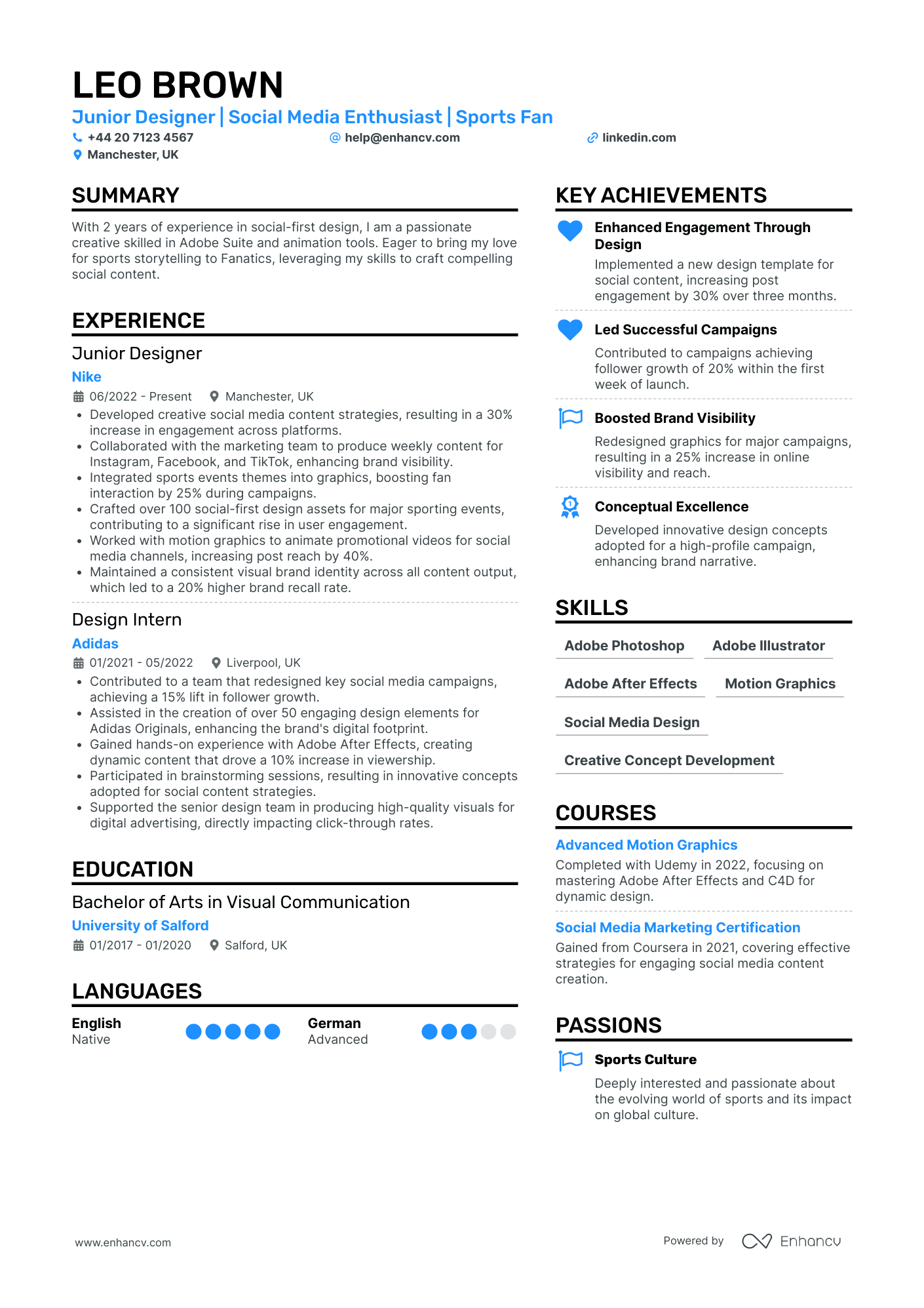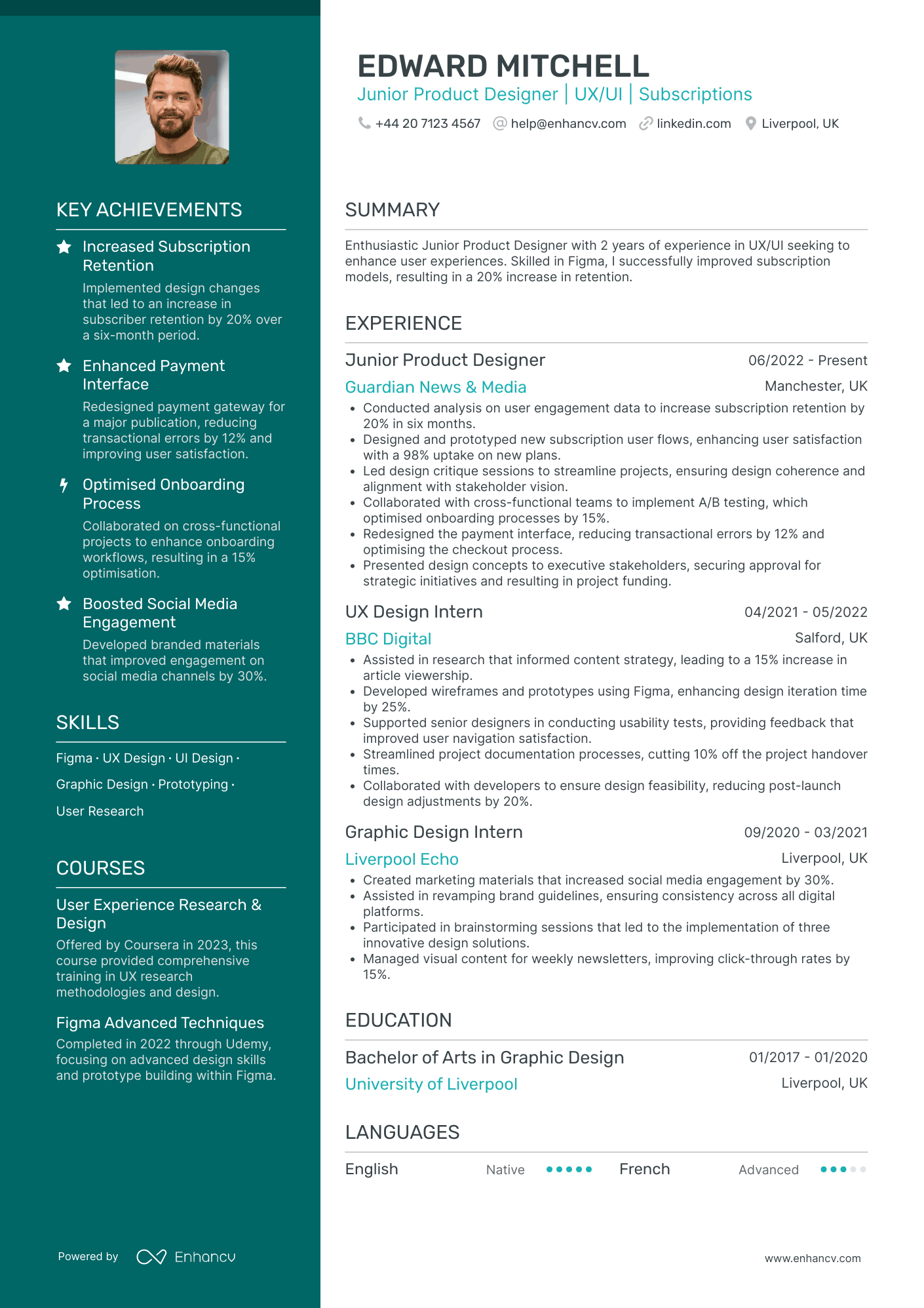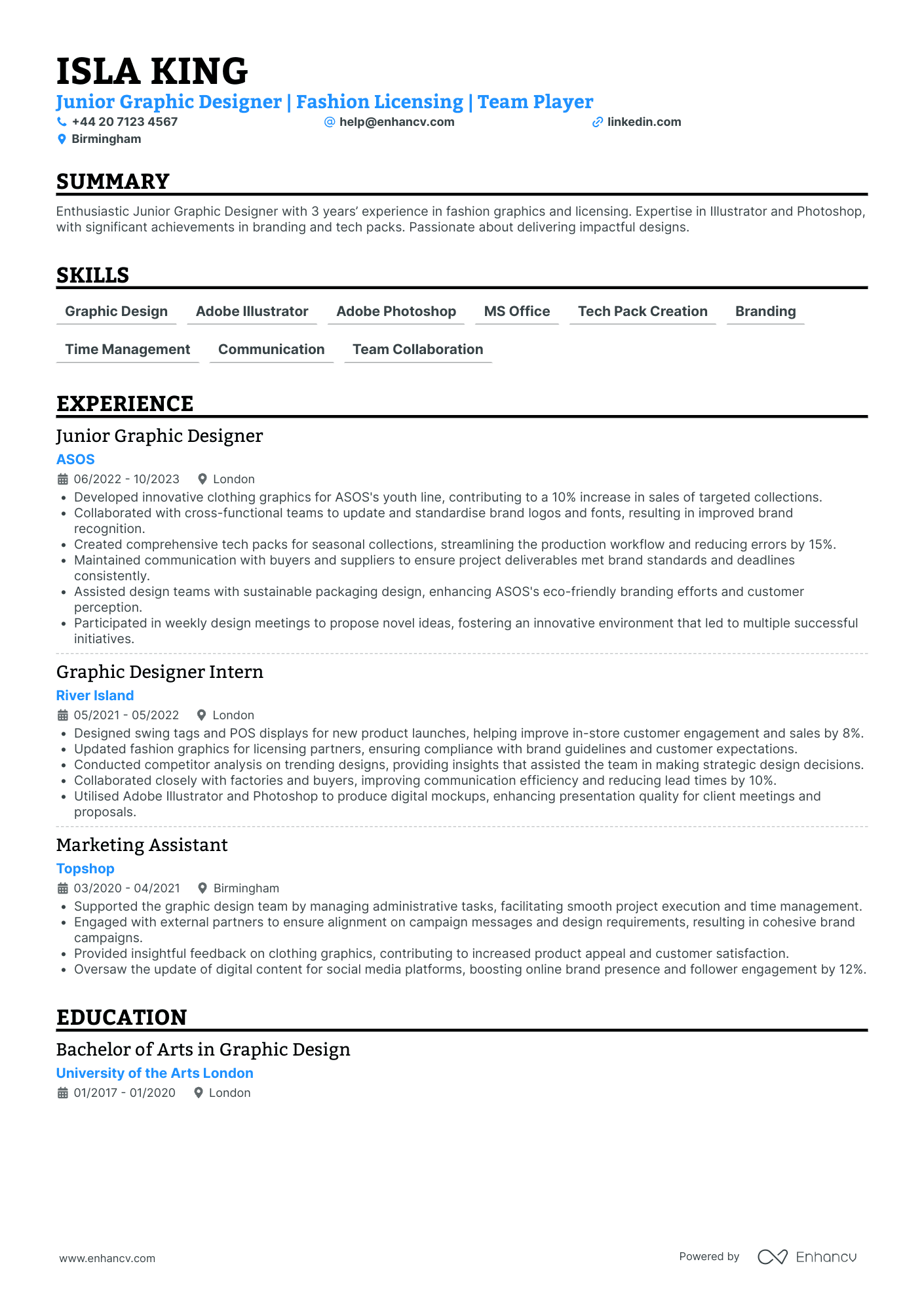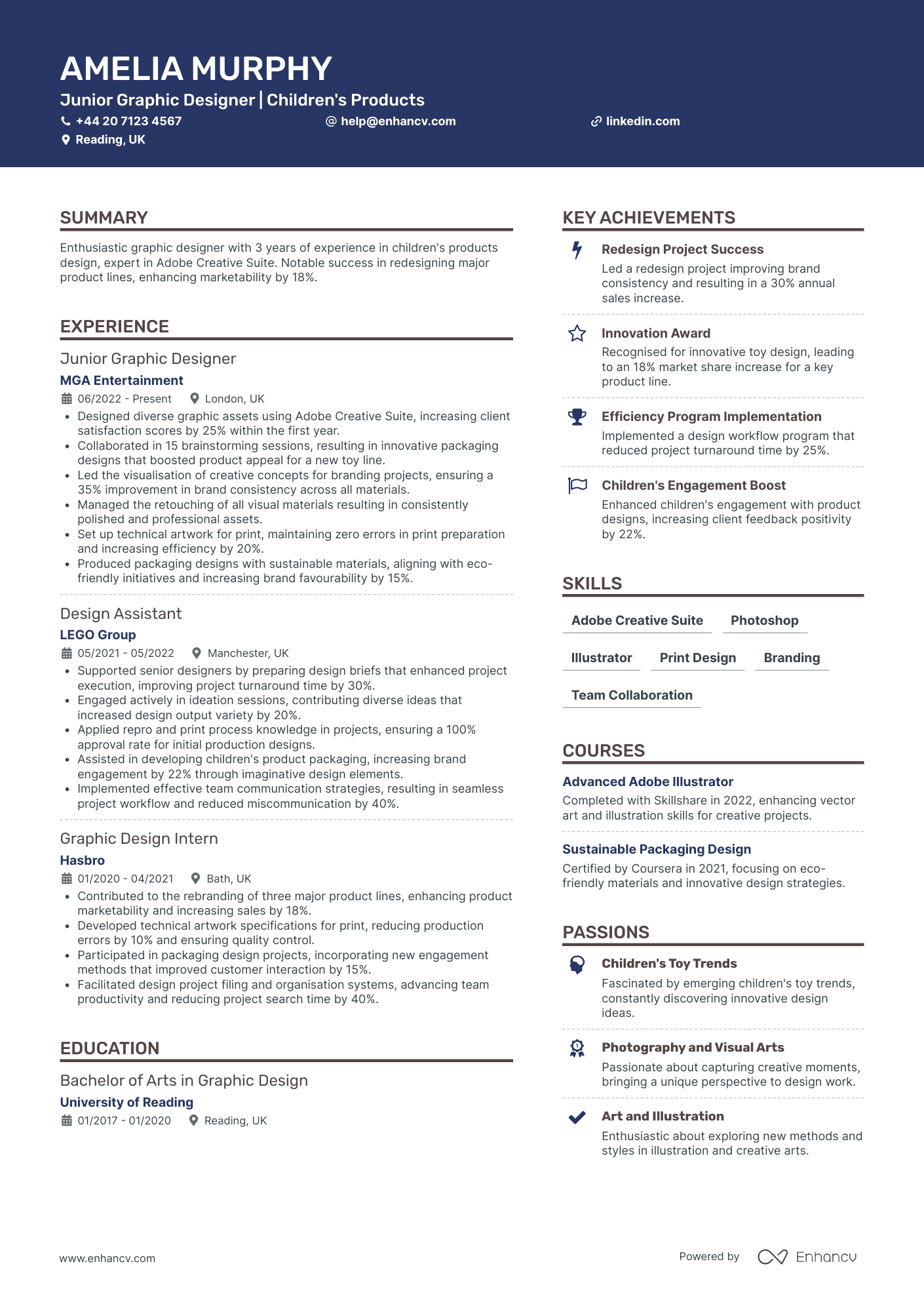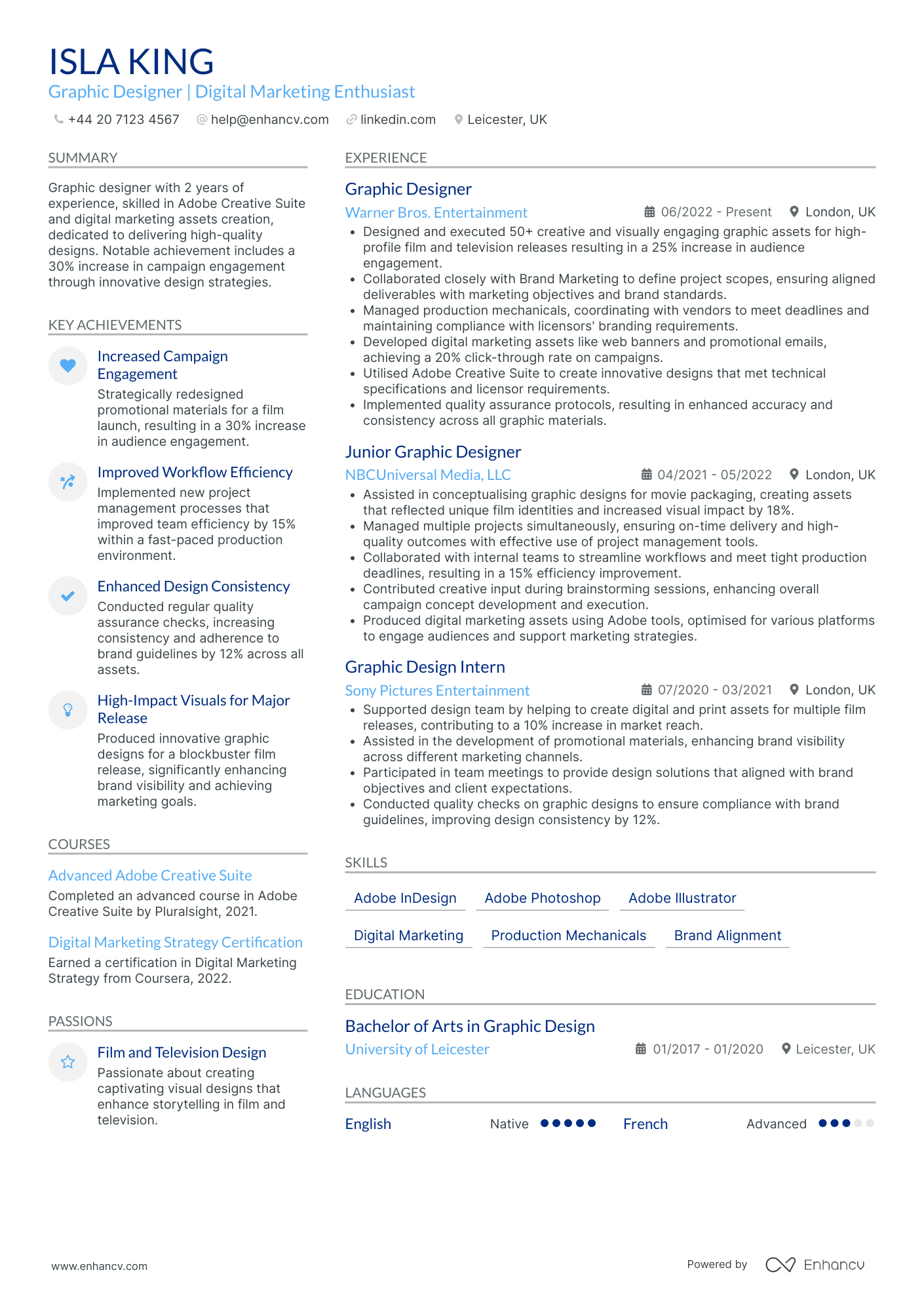Crafting a CV that stands out amidst fierce competition can be a daunting challenge for you as a junior graphic designer. Our guide offers tailored tips and industry insights to elevate your presentation, ensuring your skills capture the attention they deserve.
- Applying the simplest CV design, so that recruiters can easily understand your expertise, skills, and professional background;
- Ensuring you stand out with your header, summary or objective statement, and a designated skills section;
- Creating your CV experience section - no matter how much expertise you have;
- Using real life professional CV examples to enhance the structure and outline of your profile.
If you still have no muse to write your professional CV, find some more industry-leading examples.
Resume examples for junior graphic designer
By Experience
Apprentice Junior Graphic Designer
- Clear Structure and Conciseness - This CV excels through its well-organized structure and concise presentation of information. Each section is distinctly labeled, enabling easy navigation and comprehension. The bullet-point format efficiently distills the candidate's experiences and skills, making it reader-friendly and accessible.
- Demonstrated Growth and Experience - Eva Fisher's career trajectory is neatly outlined, showing a clear progression from a Graphic Design Intern to a Junior Graphic Designer. This evolution suggests a proactive attitude and a commitment to professional development within the field of design, reflecting her ambition and dedication.
- Use of Advanced Tools and Techniques - The CV captures industry-specific elements by listing extensive expertise with vital tools like Adobe Creative Suite, WordPress, and Google Analytics. This technical depth is reinforced by completion of relevant courses and certifications, indicating her commitment to maintaining cutting-edge skills.
Trainee Junior Graphic Designer
- Emphasizes Adaptability through Diverse Roles - The CV showcases Florence's progression from an Assistant Graphic Designer to a Junior Graphic Designer, highlighting her ability to adapt to different roles and challenges within varied environments, from design studios to major agencies like Ogilvy UK. This adaptability is pivotal for growth in the fast-evolving field of graphic design.
- Incorporates Impactful Achievements - Florence's CV is replete with achievements that go beyond mere numbers, emphasizing business relevance. For example, her role in a rebranding project that boosted brand visibility by 25% directly ties creative work to enhanced market presence, underscoring her contribution to strategic business goals.
- Focuses on Cross-Functional Collaboration - Collaboration is a recurring theme, with multiple experiences pointing to her work with cross-functional teams to achieve consistent brand representation and boost recognition by 18%. This cross-departmental synergy is critical in merging creative concepts with strategic execution, a valuable asset in any graphic design role.
Entry-Level Junior Graphic Designer
- Effective Content Presentation - Noah Jones' CV is well-structured and concise, providing clear insights into his professional journey. Each section is succinctly presented, facilitating easy navigation and allowing a quick grasp of his qualifications and accomplishments, essential for a Junior Graphic Designer.
- Consistent Career Growth - The CV illustrates a clear trajectory from an intern to a Junior Graphic Designer, showcasing his steady progress within the same industry. His transition demonstrates a solid foundation in graphic design, indicating potential for future advancement in creative design roles.
- Industry-Specific Tools and Methodologies - Jones' proficiency in the Adobe Creative Suite and web content management highlights his technical depth, a critical aspect for a graphic designer. His skills in motion graphics and coding with HTML and CSS reveal a well-rounded and versatile approach to design projects.
Graduate Junior Graphic Designer
- Clear Structure and Conciseness - The CV is well-organized, presenting information in a structured manner that enhances readability. Sections such as experience, education, skills, and achievements are clearly delineated, allowing easy navigation through the document. Concise bullet points effectively communicate key responsibilities and accomplishments without overwhelming the reader with excessive details.
- Robust Career Growth and Industry Engagement - Florence's career trajectory demonstrates steady growth, with a progression from intern roles at Channel 4 to positions as a Junior and then Graphic Designer at major companies like ITV Studios and BBC News. This demonstrates a clear upwards trajectory and increased responsibility over time, indicating strong competency and the trust of employers in her abilities in a competitive industry.
- Technical Proficiencies and Innovative Workflow - Florence’s proficiency in Adobe Creative Cloud and motion graphics tools like After Effects stands out as an industry-specific strength. The CV highlights her pivotal role in pioneering new workflows that increased efficiency by 25%, showing both technical depth and an innovative approach to graphic design challenges, important for roles requiring dynamic visual storytelling.
By Role
Junior Graphic Designer in Advertising
- Structured career progression with reputable organizations - Jack Taylor's CV illustrates a clear career trajectory, moving from a Graphic Design Intern to a Junior Graphics Designer at well-regarded financial institutions like Starling Bank and Monzo Bank. This progression highlights Jack's ability to thrive and grow within a competitive industry, showcasing an impressive leap from internship responsibilities to more complex design tasks in a junior role.
- Extensive use of industry-leading design tools - The CV showcases expertise in critical design software like Adobe Creative Suite and Canva, crucial in developing high-quality graphic and video content. Jack's proficiency in these tools underlines their technical depth and readiness to create compelling digital media, a key requirement for a Junior Graphics Designer.
- Diverse experience in collaborative and cross-functional environments - Experience working with cross-functional teams to create cohesive project presentations and branding assets shows adaptability and teamwork. Jack effectively collaborates with different departments to meet project goals, enhancing their ability to deliver unified and visually appealing designs, which is vital in a team-based environment.
Junior Graphic Designer for Digital Media
- Engagement-focused achievements - Ruby's CV excels at illustrating the impact of her work through specific achievements that emphasize engagement metrics, such as boosting reader engagement by 30% and enhancing investor understanding by 40%. These accomplishments underscore her success in crafting design solutions that not only look good but drive business results.
- Diverse skillset with modern tools - By detailing proficiency in contemporary design tools like Figma and animation techniques, Ruby's resume displays her technical depth and adaptability in the ever-evolving field of visual design. This, combined with her completed courses in advanced animation and infographic design, showcase her commitment to continuous learning and industry relevance.
- Dynamic career progression - The CV reflects Ruby's rapid progress from a Graphic Design Assistant to a Junior Graphic Designer within a span of just over three years. This trajectory highlights her ability to take on increased responsibilities and deliver impactful design solutions, making her an excellent candidate for roles requiring both creativity and business-savvy.
Junior Graphic Designer in Publishing
- Concise and Structured Presentation - The CV uses a clear and well-organized structure, segmented into distinct sections like experience, education, and skills, which allows easy navigation and quick access to pertinent information. Bullet points in the experience section contribute to a concise presentation of roles and achievements without overwhelming details, ensuring clarity and focus.
- Demonstrated Career Progression - From an intern at AKQA to a Junior Digital Designer at Hugo & Cat, Oscar's career trajectory showcases a clear path of growth within the digital design industry. This progression highlights increasing responsibilities and the development of advanced skills, reflecting ambition and a commitment to professional development.
- Integration of Technology and Creativity - Oscar effectively combines technical proficiency with creative skills, utilizing tools like Adobe Creative Suite, Content Management Systems, and motion graphics software to deliver innovative and engaging design solutions. The inclusion of unique tools and certifications reflects a deep industry-specific knowledge and a commitment to staying current with the latest technologies.
Junior Graphic Designer for Web Development
- Strong Emphasis on Communication and Collaboration - Noah's CV underscores his dedication to effective communication and team collaboration. It illustrates his capacity to conduct over 80 meetings between diverse stakeholders, enhancing cooperation and project outcomes. This focus on stakeholder engagement showcases his leadership abilities and readiness to ensure everyone is aligned with project goals.
- Clear Career Progression in Project Management - The CV outlines a logical career path from a Project Management Intern to a Web Development Consultant. This progression highlights Noah’s growing responsibilities and his shift toward more specialized consultancy roles, indicating a focused commitment to advancing within the field of web development and project management.
- Impact-Driven Achievements with Tangible Results - Achievements noted in the CV focus on significant improvements in project delivery times and client satisfaction. Through structured requirement gathering and workflow enhancements, Noah's ability to influence business operations positively demonstrates his proficiency in delivering value and efficiency to clients.
Junior Graphic Designer in Animation
- Concise and Clear Layout - The CV presents all relevant information in a well-structured manner, making it easy for employers to immediately grasp Henry's qualifications and expertise. Each section flows logically, allowing for a seamless navigation through his background and professional experiences.
- Demonstrates Strong Growth in Design - Henry's career path shows a clear progression from an internship at LUSH to a junior designer role at ASOS. This trajectory highlights his ability to take on more responsibilities, indicating a strong foundation in graphic and motion design with room for further development.
- Technical Proficiency in Industry-Standard Tools - The CV specifies Henry's expertise in crucial design software such as Adobe Photoshop, Illustrator, and After Effects. His knowledge of these tools showcases his industry readiness and technical capabilities essential for producing high-quality digital designs.
Junior Graphic Designer for Branding
- Clarity and Structured Presentation - The CV is laid out in a structured manner, making it easy to read and navigate. Each section is clearly defined, and the use of bullet points ensures brevity and focus, allowing key achievements and responsibilities to stand out without overwhelming the reader.
- Career Advancement and Industry Growth - Freya Richardson’s career trajectory shows a clear progression from intern to junior designer, demonstrating growth within reputable design companies like Pentagram and Fjord. This upward movement reflects her ability to adapt, learn, and thrive in a competitive industry.
- Technical Skills and Tools - The CV highlights Freya’s proficiency with industry-standard design tools, including the complete Adobe Creative Suite. Her technical depth is further reinforced by a focus on advanced typography, web design, and UX principles, which are critical skills in graphic design roles.
Junior Graphic Designer in Print Media
- Concise and Impactful Summary - The CV starts with a well-crafted summary that succinctly captures Sophia Brooks' skills in Adobe Creative Cloud and emphasizes her prowess in storytelling and brand engagement, providing an immediate insight into her professional focus and potential value to employers.
- Clear Demonstration of Career Growth - Sophia's progression from an intern at Estée Lauder to a Junior Designer at Glossier illustrates a solid trajectory in the design field, highlighting her ability to advance rapidly and take on more responsibilities, which is indicative of her dedication and capability.
- Business Impact of Achievements - Rather than merely listing accomplishments, the CV effectively conveys the business impact of Sophia's work by quantifying results such as increased social media engagement, improved customer interest, and enhanced consumer recognition, demonstrating her strategic contribution to corporate goals.
Junior Graphic Designer for E-commerce
- Structured and Clear Presentation - The CV is well-organized, ensuring clarity by using distinct sections such as experiences, education, skills, and achievements. Information is presented concisely, with bullet points highlighting achievements and impactful contributions, making it easy for hiring managers to quickly assess the candidate's capabilities.
- Career Growth in Design Roles - Charlie Thomas has shown a clear career trajectory from an internship to a full-time Junior Graphic Designer role in less than a year, indicating a fast-learning capability and adaptability. This progression within the competitive design industry showcases their dedication and skill development.
- Focus on E-commerce and Visual Storytelling - The CV emphasizes industry-specific skills like proficiency in Adobe Creative Suite and brand consistency, demonstrating technical depth. Moreover, achievements such as a 20% increase in digital sales through ad campaigns underline their expertise in e-commerce and sales visuals, directly relevant to the position.
Junior Graphic Designer in Gaming
- Effective Career Progression - Thomas Walker’s CV outlines a clear trajectory from Junior to Associate Game Designer. The growth is consistent with increasing responsibilities and achievements, with experiences at industry-renowned companies like King and Playdemic, suggesting a solid foundation and readiness for more advanced roles.
- Focus on Game Design Innovation - The CV stands out by emphasizing unique industry-specific skills such as player-centric design and prototyping tools. Thomas is well-versed in gaming fundamentals, including scripting and F2P monetization, positioning him as a forward-thinking designer adept at pushing the boundaries of mobile gaming experiences.
- Cross-disciplinary Collaboration Skills - Thomas’s experience reflects strong adaptability, having worked alongside artists, developers, and cross-functional teams. This collaboration has not only enhanced team productivity by 30% but also led to recognition for innovative gameplay, addressing critical industry challenges through team-driven solutions.
Junior Graphic Designer for UX/UI Design
- Clarity and Structure in Presentation - The CV is structured in a clear and organized manner, ensuring concise presentation of information across its sections. It effectively divides content into easily digestible parts while maintaining a cohesive flow, aiding in readability and comprehension for hiring managers.
- Distinctive Career Trajectory with Strategic Development - Sienna West has shown a natural progression in her career, advancing from a Design Intern to a Mid-weight Brand Designer. This growth underscores her ability to continuously leverage her skills across increasingly complex roles, specifically within the healthcare industry, marking her as a strategic thinker capable of advancing brand objectives.
- Impact-Driven Achievements with Business Significance - The CV highlights achievements that extend beyond mere numbers by aligning them with business objectives, such as enhancing brand identity to boost engagement and user retention, and facilitating rebranding efforts to solidify corporate identity. These accomplishments are underscored by metrics that reflect Sienna’s influence on business outcomes, demonstrating her capability to derive meaningful improvements in brand strategy execution.
Junior Graphic Designer in Marketing
- Comprehensive structure with clear sections - The CV is well-organized into distinct sections, such as experience, education, skills, and achievements, which makes it easy for readers to quickly identify pertinent information related to the marketing designer role. The clarity in content presentation ensures quick comprehension of the candidate’s professional experience and capabilities.
- Progressive career development in key industry players - Throughout his career, Archie demonstrates notable growth, starting as a Design Intern and advancing to a Marketing Designer at ASOS. The experience reflects a continuous learning curve and adaptability within prominent e-commerce companies, indicating his ability to acclimate and thrive in highly competitive environments.
- Highlighting innovative design tools and methodologies - Archie's expertise with industry-standard tools like Figma and Adobe Suite and his implementation of rapid prototyping techniques distinguish him in the e-commerce sector. His technical background in these tools has driven improved efficiency and engagement, underlining his practical industry knowledge.
Junior Graphic Designer for Social Media
- Effective Structure and Clarity - The CV is well-organized, utilizing clear section headings and a logical flow from personal details to experiences, education, and skills. This allows for quick navigation and readability, emphasizing the content’s relevance to the reader from the outset.
- Progressive Career Development - Leo's career trajectory demonstrates consistent growth in brand positions within world-renowned companies like Nike and Adidas. This progression underlines their evolution from an intern to a fully-fledged junior designer, showcasing their ability to gain increasing levels of responsibility and impact within the industry.
- Advanced Technical Competencies - The CV highlights Leo's command of industry-specific tools and methodologies, such as Adobe Suite, After Effects, and C4D. This technical proficiency highlights their capability to deliver cutting-edge design solutions, essential for roles focused on innovation in digital and motion graphics.
Junior Graphic Designer in Product Design
- Concise and targeted content presentation - The CV's content is presented clearly and concisely, providing a structured and focused summary of the candidate’s qualifications and experience. Key sections are outlined with precise bullets that convey the candidate’s achievements and skills effectively, making it easy for employers to assess the applicant's suitability for a product design role.
- Consistent career trajectory with significant growth - Edward Mitchell's career path reflects steady growth in the design industry. Starting from a Graphic Design Intern to becoming a Junior Product Designer at a reputable newspaper, his progression demonstrates an increase in responsibility and mastery of complex design tasks over time, notably impacting subscription models and user experience in his current role.
- Robust application of industry-specific tools and methodologies - This CV highlights advanced technical proficiency in using industry-standard tools such as Figma and Adobe Creative Suite, reinforced by specialized courses in UX research and advanced Figma techniques. These skills and methodologies are critical for a Junior Product Designer role, showcasing the candidate's readiness to contribute effectively to a design team.
Junior Graphic Designer for Fashion Industry
- Clear and Concise Presentation - The CV exhibits a clear and structured layout, making it easy to navigate through the candidate's background. Each section is distinctly partitioned, and bullet points effectively condense detailed information into digestible, impactful statements that offer a quick yet comprehensive overview of Isla King's qualifications.
- Steady Career Growth - Isla King's career trajectory is marked by steady advancement from a Marketing Assistant to a Junior Graphic Designer role. This progression demonstrates not only an upward career path but also a strategic shift towards specialization in graphic design within the fashion industry, highlighting adaptability and commitment to refining specific skills.
- Technical Proficiency in Industry Tools - The CV lists key industry-standard tools such as Adobe Illustrator and Photoshop, reflecting technical depth and proficiency essential for success in graphic design roles. Isla's completion of advanced courses indicates a keen interest in continuous learning and staying updated with the latest techniques, which is crucial for maintaining relevance in a fast-evolving field like fashion design.
Junior Graphic Designer in Packaging
- Structure and Clarity - This CV is well-organized and easy to navigate, with distinct sections dedicated to experience, education, skills, achievements, and personal interests. Each section is clearly labeled, allowing potential employers to quickly find relevant information about the candidate's qualifications and background.
- Career Progression - Amelia Murphy's career path demonstrates significant growth, moving from a Graphic Design Intern to a Junior Graphic Designer within prominent companies like Hasbro and MGA Entertainment. This trajectory highlights her upward mobility and increasing responsibilities in the field of children's products design.
- Industry-Specific Skills and Tools - The CV showcases Amelia's proficiency with industry-standard tools such as Adobe Creative Suite, Photoshop, and Illustrator. Additionally, her expertise in sustainable packaging and repro and print processes highlights her technical depth and awareness of ecologically conscious design trends specific to the children's product market.
Junior Graphic Designer for Film and Television
- Clear and Structured Presentation - The CV is well-organized, featuring distinct sections that provide a comprehensive view of the candidate’s qualifications. Each segment is structured to deliver concise, impactful information, making it easy for readers to grasp the depth of Isla King's skills and experiences.
- Diverse Industry Experience and Growth - Isla King's career trajectory is marked by steady growth, transitioning from an intern to a graphic designer at well-known entertainment companies. This progression highlights her ability to excel and advance within the competitive entertainment industry, underscoring her capacity to take on increasingly complex roles.
- Noteworthy Achievements with Business Impact - The CV emphasizes key accomplishments that go beyond numerical success, detailing how Isla King's contributions led to significant engagement and efficiency gains. Her achievements, such as increasing campaign engagement by 30% and improving workflow efficiency by 15%, demonstrate her impact on the organizations she has worked with, providing a clear link between her efforts and business success.
Structuring and formatting your junior graphic designer CV for an excellent first impression
The experts' best advice regarding your CV format is to keep it simple and concise. Recruiters assessing your CV are foremost looking out for candidates who match their ideal job profile. Your white space, borders, and margins. You may still be wondering which format you need to export your CV in. We recommend using the PDF one, as, upon being uploaded, it never alters your information or CV design. Before we move on to the actual content of your junior graphic designer CV, we'd like to remind you about the Applicant Tracker System (or the ATS). The ATS is a software that is sometimes used to initially assess your profile. Here's what you need to keep in mind about the ATS:
- All serif and sans-serif fonts (e.g. Rubik, Volkhov, Exo 2 etc.) are ATS-friendly;
- Many candidates invest in Arial and Times New Roman, so avoid these fonts if you want your application to stand out;
- Both single and double column CVs can be read by the ATS, so it's entirely up to you to select your CV design.
PRO TIP
Use bold or italics sparingly to draw attention to key points, such as job titles, company names, or significant achievements. Overusing these formatting options can dilute their impact.
The top sections on a junior graphic designer CV
- Personal Profile summarises your unique design ethos and career goals, catching the recruiter's eye.
- Work Experience details your relevant design roles, showcasing your growth and industry insight.
- Design Portfolio link is critical, enabling recruiters to assess your creativity and technique firsthand.
- Education & Training highlights your formal design qualifications and any specialised industry knowledge.
- Technical Skills section lists proficient design software and tools, demonstrating your practical design capabilities.
What recruiters value on your CV:
- Highlight your proficiency in design software, such as Adobe Creative Suite, by providing examples of projects where you've utilised these tools to create stunning visuals or layouts.
- Include a personal design statement that showcases your creative philosophy and approach to graphic design, making it relatable to the junior level position you're aiming for.
- Showcase a diverse portfolio within your CV or through an attached link, emphasising your adaptability and ability to work on various types of graphic design projects.
- Detail any collaborative projects or internships that exemplify your ability to work in a team and contribute effectively to group tasks, as teamwork is often crucial in design roles.
- Emphasise any educational assignments or personal projects that demonstrate your ability to think conceptually and solve design problems, as creative problem-solving is key for a junior graphic designer.
Recommended reads:
Tips and tricks on writing a job-winning junior graphic designer CV header
The CV header is the space which most recruiters would be referring most often to, in the beginning and end of your application. That is as the CV header includes your contact details, but also a headline and a professional photo. When writing your CV header:
- Double-check your contact details for spelling errors or if you've missed any digits. Also, ensure you've provided your personal details, and not your current work email or telephone number;
- Include your location in the form of the city and country you live in. If you want to be more detailed, you can list your full address to show proximity to your potential work place;
- Don't include your CV photo, if you're applying for roles in the UK or US, as this may bias initial recruiters' assessments;
- Write a professional headline that either integrates the job title, some relevant industry keywords, or your most noteworthy achievement.
In the next part of our guide, we'll provide you with professional CVs that showcase some of the best practices when it comes to writing your headline.
Examples of good CV headlines for junior graphic designer:
- Junior Graphic Designer | Specialising in Branding & Digital Media | Adobe Certified | 2+ Years Experience
- Creative Junior Graphic Designer | Expert in Illustration & Print Design | BA Hons | 1 Year Professional
- Aspiring Junior Designer | UI/UX Focus | Advanced Photoshop Skills | Recent Graduate
- Innovative Junior Graphic Artist | Motion Graphics Enthusiast | 3+ Years Agency Experience
- Fresh Junior Visual Designer | Typography & Layout Expertise | MA Visual Communication | 2 Years Freelance
- Junior Graphic Designer | Passion for Eco-Friendly Design | Proficient in InDesign | 18 Months Industry Experience
Choosing your opening statement: a junior graphic designer CV summary or objective
At the top one third of your CV, you have the chance to make a more personable impression on recruiters by selecting between:
- Summary - or those three to five sentences that you use to show your greatest achievements. Use the CV summary if you happen to have plenty of relevant experience and wish to highlight your greatest successes;
- Objective - provides you with up to five sentences to state your career goals and aspirations
CV summaries for a junior graphic designer job:
CV objectives for a junior graphic designer job:
How to ensure your junior graphic designer CV stands out when you have no experience
This part of our step-by-step guide will help you substitute your experience section by helping you spotlight your skill set. First off, your ability to land your first job will depend on the time you take to assess precisely how you match the job requirements. Whether that's via your relevant education and courses, skill set, or any potential extracurricular activities. Next:
- Systematise your CV so that it spotlights your most relevant experience (whether that's your education or volunteer work) towards the top;
- Focus recruiters' attention to your transferrable skill set and in particular how your personality would be the perfect fit for the role;
- Consider how your current background has helped you build your technological understanding - whether you've created projects in your free time or as part of your uni degree;
- Ensure you've expanded on your teamwork capabilities with any relevant internships, part-time roles, or projects you've participated in the past.
Recommended reads:
PRO TIP
Order your skills based on the relevance to the role you're applying for, ensuring the most pertinent skills catch the employer's attention first.
The CV skills' divide: between hard and soft skills
Of course, you may have read the job requirements plenty of times now, but it's key to note that there is a difference between technical and personal skills. Both are equally relevant to your job application. When writing about your skill set, ensure you've copy-pasted the precise skill from the job requirement. This would not only help you ensure you have the correct spelling, but also pass any Applicant Tracker System (ATS) assessments.
- Hard skills show your technological capabilities. Or whether you'll be a good technical fit to the organisation. Ensure you've spotlighted your hard skills in various sections of your CV (e.g. skills section, projects, experience) by including the technology and what you've attained;
- Soft skills pinpoint your personality and people or communication skills, hinting at if you'll easily accomodate into the team or organisation. Quantify your soft skills in your CV achievements, strengths, summary/objective, and experience sections. Always support your soft skills with how they've helped you grow as a professional.
Top skills for your junior graphic designer CV:
Adobe Creative Suite proficiency
Understanding of typography
Knowledge of colour theory
Layout design ability
Basic HTML and CSS knowledge
Brand identity design
UX/UI principles awareness
Vector graphics creation
Digital illustration
Photo editing and retouching
Creativity
Attention to detail
Time management
Communication skills
Problem-solving ability
Adaptability
Teamwork
Openness to feedback
Continuous learning
Project management
PRO TIP
If you have received professional endorsements or recommendations for certain skills, especially on platforms like LinkedIn, mention these to add credibility.
Your university degree and certificates: an integral part of your junior graphic designer CV
Let's take you back to your uni days and decide what information will be relevant for your junior graphic designer CV. Once more, when discussing your higher education, select only information that is pertinent to the job (e.g. degrees and projects in the same industry, etc.). Ultimately, you should:
- List only your higher education degrees, alongside start and graduation dates, and the university name;
- Include that you obtained a first degree for diplomas that are relevant to the role, and you believe will impress recruiters;
- Showcase relevant coursework, projects, or publications, if you happen to have less experience or will need to fill in gaps in your professional history.
PRO TIP
If you have received professional endorsements or recommendations for certain skills, especially on platforms like LinkedIn, mention these to add credibility.
Recommended reads:
Key takeaways
What matters most in your junior graphic designer CV-writing process is for you to create a personalised application. One that matches the role and also showcases your unique qualities and talents.
- Use the format to supplement the actual content, to stand out, and to ensure your CV experience is easy to comprehend and follows a logic;
- Invest time in building a succinct CV top one third. One that includes a header (with your contact details and headline), a summary or an objective statement (select the one that best fits your experience), and - potentially - a dedicated skills section or achievements (to fit both hard skills and soft skills requirements);
- Prioritise your most relevant (and senior) experience closer to the top of your CV. Always ensure you're following the "power verb, skill, and achievement" format for your bullets;
- Integrate both your technical and communication background across different sections of your CV to meet the job requirements;
- List your relevant education and certificates to fill in gaps in your CV history and prove to recrutiers you have relevant technical know-how.
